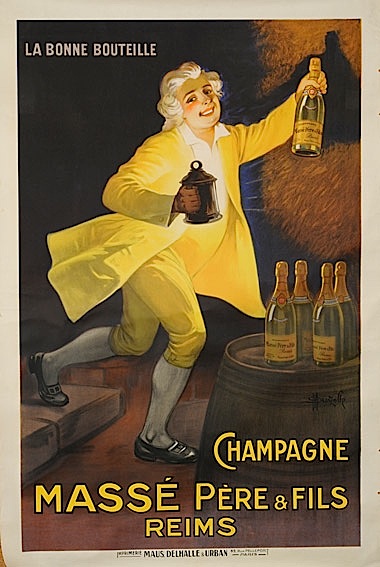MARIANI’SVirtual Gourmet
January 8,
2012
NEWSLETTER
THIS WEEK
EATING AROUND AUSTIN
by John Mariani
NEW YORK CORNER
The Leopard
by
John Mariani
NOTES FROM THE WINE CELLAR
A
RAPID RISE IN CROATIAN WINE QUALITY,
BUT NOW HOW AND WHERE TO SELL IT?
by
John Mariani
❖❖❖
EATING AROUND
AUSTIN
by John Mariani

Austin has always had good food but in the last few years restaurants have moved upscale without betraying the city's casual Texas swagger. The fact that it's a college town means the bar scene, largely along Sixth Street, is tied into beer-fueled Mexican, Tex-Mex, and barbecue eats. As shown in last week's Part One on Austin, the music scene adds another dynamo to these same bars and eateries, and the overall economy, buoyed by the headquarters of Dell and the public weal of the state capital, is doing well enough to encourage everything from high-end dining to upscale sushi.
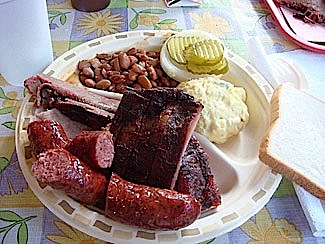 Those
in search of local 'cue keep Stubb’s
Bar-B-Que (801 Red River
Street) on speed dial, and it's famous for
its Sunday gospel brunch; My own
favorite is
Iron Works
BBQ (100 Red River Street),
whose ancient structure still shows signs of the
terrible 1935 Austin flood (holes in the floor are
covered with license plates); these days it’s
decked out in Texas kitsch, and has hosted
Kevin Costner, Leonardo DiCaprio, Bob Dylan, and Jay
Leno. I find Iron Works’ sliced beef brisket and beef
ribs to be exemplary of Texas smoking and
grilling; their hot sausage and smoked turkey (left) have the
perfect pungency that requires a side of fine, creamy
potato salad and the sweet pinto beans, along with a
bottle of Shiner Bock beer plucked from an ice chest.
(Wherever
you go, do not let anyone drag you to either
of the local County Line BBQ places, which are
as awful in service as they are for 'cue for the
masses.)
Of course, if you've got wheels, it is a requisite
pilgrimage to visit Kreuz
Market in Lockhart, TX, for what many
consider the paragon of Texas-style 'cue.
Those
in search of local 'cue keep Stubb’s
Bar-B-Que (801 Red River
Street) on speed dial, and it's famous for
its Sunday gospel brunch; My own
favorite is
Iron Works
BBQ (100 Red River Street),
whose ancient structure still shows signs of the
terrible 1935 Austin flood (holes in the floor are
covered with license plates); these days it’s
decked out in Texas kitsch, and has hosted
Kevin Costner, Leonardo DiCaprio, Bob Dylan, and Jay
Leno. I find Iron Works’ sliced beef brisket and beef
ribs to be exemplary of Texas smoking and
grilling; their hot sausage and smoked turkey (left) have the
perfect pungency that requires a side of fine, creamy
potato salad and the sweet pinto beans, along with a
bottle of Shiner Bock beer plucked from an ice chest.
(Wherever
you go, do not let anyone drag you to either
of the local County Line BBQ places, which are
as awful in service as they are for 'cue for the
masses.)
Of course, if you've got wheels, it is a requisite
pilgrimage to visit Kreuz
Market in Lockhart, TX, for what many
consider the paragon of Texas-style 'cue.
Mexican restaurants abound in Austin, led
by the very beautiful Fonda San Miguel
(2330 W. North Loop), here since 1975,
serving a classic style of Mexican fare. Far
more downhome is El
Chile Café & Cantina (1809
Manor Road), which does a mix of Mexican and
Tex-Mex, and is especially good for its antojitos
(appetizers) like mildly spicy tilapia ceviche
with lime juice, tomato, onion, and cilantro; grilled
quesadillas with chorizo and Chihuahua cheese;
and a terrific tortilla soup in a rich chicken broth
with avocado, queso fresco, tortilla strips,
and laced with cream.
Garrido's
(360 Nueces)
is a more modern take on Mexican food, with highly
personalized cooking via Chef-owner David Garrido.
It's 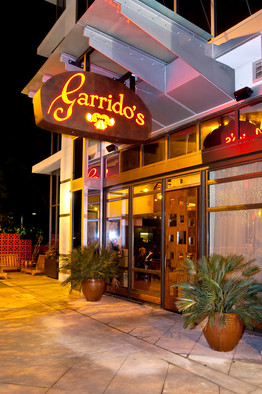 a very handsome, very sunny restaurant
during the day, and he's clearly using the very best
ingredients in dishes like his bocaditos of
shrimp tostadas
with chipotle-horseradish and the pork tostadas with
goat's cheese, pepitas,
watermelon and a hot-and-sweet chipotle glaze.
a very handsome, very sunny restaurant
during the day, and he's clearly using the very best
ingredients in dishes like his bocaditos of
shrimp tostadas
with chipotle-horseradish and the pork tostadas with
goat's cheese, pepitas,
watermelon and a hot-and-sweet chipotle glaze.
He offers a whole slew of delicious
tacos, including many for breakfast and lunch, while
his dinner entrees are expressive of why he's one of
the most talented chefs working in the modern Mexican
style. Pork carnitas
(for two) with tomatillo salsa, guacamole and rice and beans
is plenty of good food, and there is a Gulf red
snapper pan-seared and topped with guajillo-caper
butter, served with polenta and vegetables, and five
different kinds of enchiladas. Bring friends,
have a margarita, get poco loco.
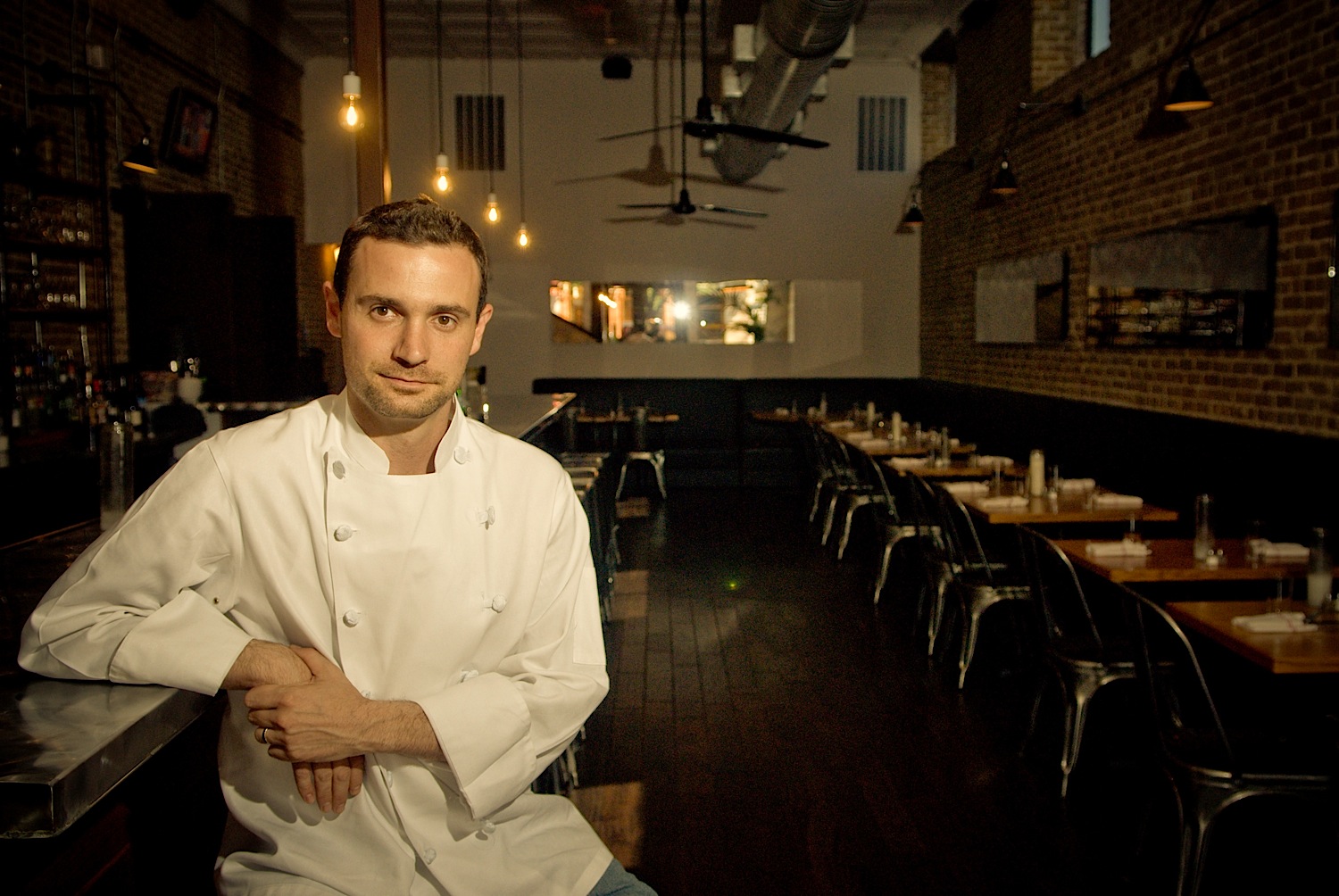 For
contemporary American food with very canny European
underpinnings, I highly recommend the very
popular Parkside
(301 East 6th Street), with a hip downstairs
raw bar serving up small plates, from ten species of
oysters to a grilled cheese sandwich, and marrow
bones. The main dining room menu features an
appetizer selection of classic steak tartare; Texas
quail with capers and tomato; fried
calamari with smoky paprika, and addictive hot
crab fritters you dip into a garlicky sauce ravigote.
Chef-owner Shawn Cirkiel’s nightly specials offer the
most creativity, and the main dishes get hefty in size
but not in price (nothing runs above $25), with items
like braised beef cheeks and buttered spaetzel,
and grilled venison with farro grain and tender
Brussels sprouts.
For
contemporary American food with very canny European
underpinnings, I highly recommend the very
popular Parkside
(301 East 6th Street), with a hip downstairs
raw bar serving up small plates, from ten species of
oysters to a grilled cheese sandwich, and marrow
bones. The main dining room menu features an
appetizer selection of classic steak tartare; Texas
quail with capers and tomato; fried
calamari with smoky paprika, and addictive hot
crab fritters you dip into a garlicky sauce ravigote.
Chef-owner Shawn Cirkiel’s nightly specials offer the
most creativity, and the main dishes get hefty in size
but not in price (nothing runs above $25), with items
like braised beef cheeks and buttered spaetzel,
and grilled venison with farro grain and tender
Brussels sprouts.
Cirkiel (above) has also opened a terrific
new pizzeria nearby, called Backspace
(507 San Jacinto).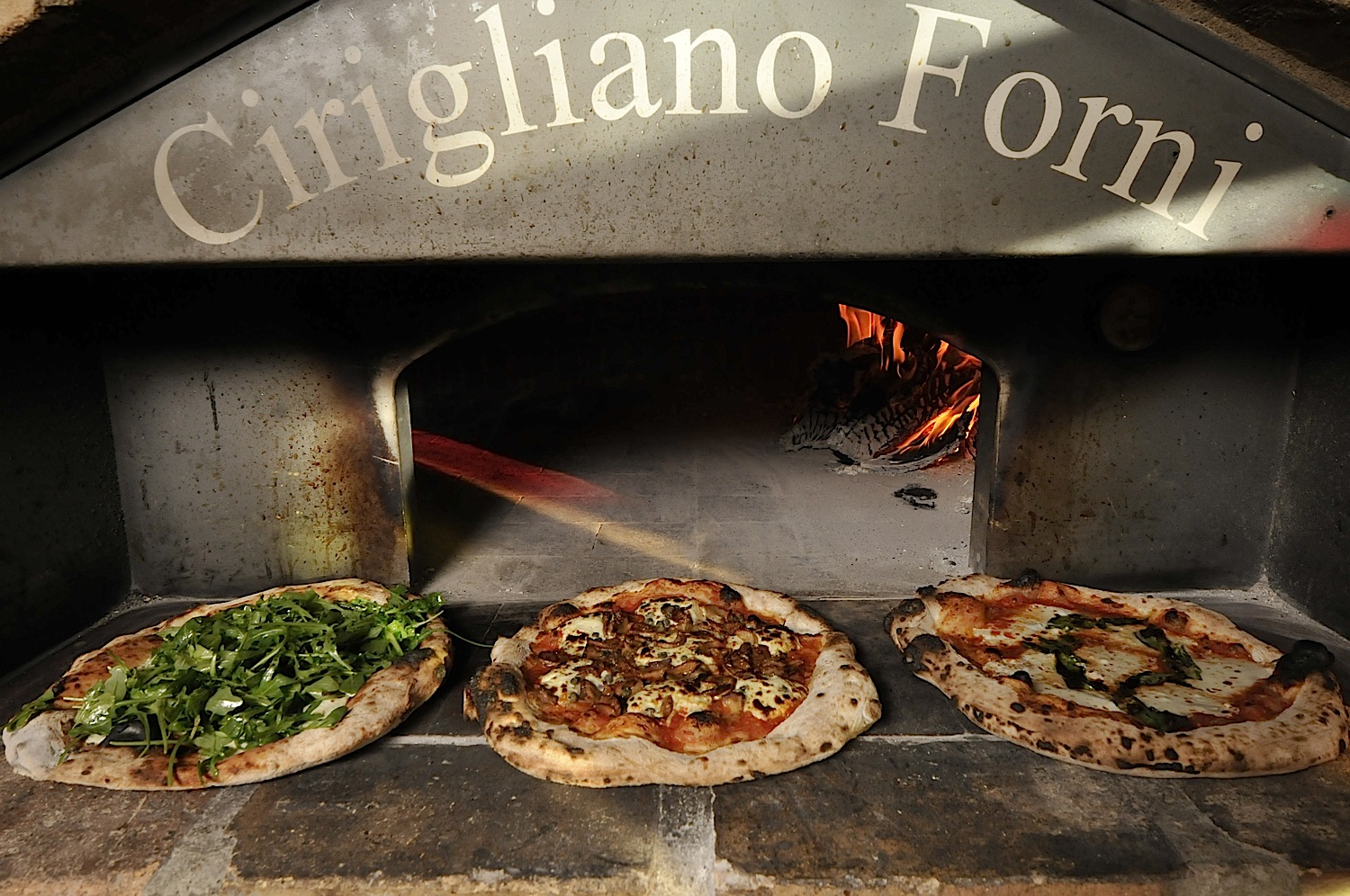 Taking his
inspiration--and following through--from the original
pizzaioli of
Naples itself. Cirkiel had at great expense a
handcrafted pizza oven (right) shipped over (it took
forever), and he and his crew have really learned how
to work that fiery furnace to produce impeccable
pizzas with the right thickness, cornicione edge,
and crackling, bubbly, charred surface with a fine
balance of ingredients on top, none of which betray
Neapolitan traditions. So, you will find the classic margherita, along
with toppings of fennel sausage, white anchovies,
ricotta, and other items, the highest priced pie at
$15. There is also good Italian salume and
cheeses along with antipasti
like oven-roasted ratatouille and lamb-and-pork
meatballs with asiago cheese.
Taking his
inspiration--and following through--from the original
pizzaioli of
Naples itself. Cirkiel had at great expense a
handcrafted pizza oven (right) shipped over (it took
forever), and he and his crew have really learned how
to work that fiery furnace to produce impeccable
pizzas with the right thickness, cornicione edge,
and crackling, bubbly, charred surface with a fine
balance of ingredients on top, none of which betray
Neapolitan traditions. So, you will find the classic margherita, along
with toppings of fennel sausage, white anchovies,
ricotta, and other items, the highest priced pie at
$15. There is also good Italian salume and
cheeses along with antipasti
like oven-roasted ratatouille and lamb-and-pork
meatballs with asiago cheese.
I'd tell anyone considering opening
a new pizzeria in America that he need not fly to
Naples to find out the secrets. Instead, fly to Austin
and hang around Backspace for a few days. Cirkiel
knows what he's doing.
Congress, an
elegantly comfortable fine dining restaurant that
received the Austin
Statesman’s first ever five-star review and was
one of my picks for Esquire's
"Best New Restaurants 2011," is owned by Chef
David Bull, who draws on the huge Texas cornucopia to
create dishes like grilled sweetbreads with spring
radish and smoked poppy seeds in a buttermilk crema, and
beef tartare with fried oysters, truffles, and
Parmesan cheese.
There’s a seven-course tasting menu at $115
that will tell you everything you need to know about
Bull’s talent.
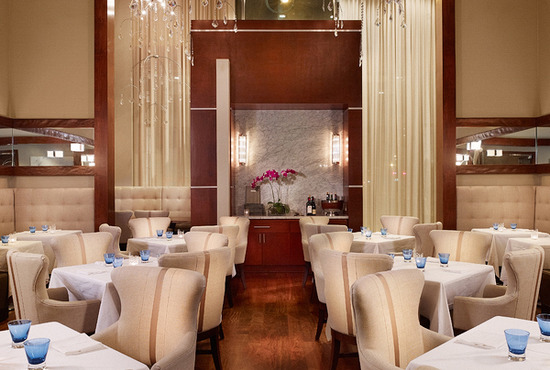 “Texas has
always been the underdog in the world of cuisine,"
Bull told me, "and still today conjures up visions of
BBQ, taco stands,
and tumbleweeds.
Yet it has one of the most diverse traditions
and history from a unique melting pot of people, ideas
and ingredients. Especially where we are in central
Texas, we are a far cry from limiting ourselves to the
typical stereotypes, and our chefs have been cooking
at the level of L.A., New York and Chicago for many
years. Central
Texas has such a wealth and abundance of great product
it makes my job a lot easier to look here first when
creating a new dish.
We have direct access to some of the best beef
and game in the country, along with our own coastal
seafood. We get terrific Axis venison and antelope
from Broken Arrow Ranch in south Texas, red snapper
and an array of oysters from the Gulf of Mexico, and
our local peaches and figs and squash are first rate.
There are also the Hill Country wineries—about 30 of
them now—making some fine varietals.
“Texas has
always been the underdog in the world of cuisine,"
Bull told me, "and still today conjures up visions of
BBQ, taco stands,
and tumbleweeds.
Yet it has one of the most diverse traditions
and history from a unique melting pot of people, ideas
and ingredients. Especially where we are in central
Texas, we are a far cry from limiting ourselves to the
typical stereotypes, and our chefs have been cooking
at the level of L.A., New York and Chicago for many
years. Central
Texas has such a wealth and abundance of great product
it makes my job a lot easier to look here first when
creating a new dish.
We have direct access to some of the best beef
and game in the country, along with our own coastal
seafood. We get terrific Axis venison and antelope
from Broken Arrow Ranch in south Texas, red snapper
and an array of oysters from the Gulf of Mexico, and
our local peaches and figs and squash are first rate.
There are also the Hill Country wineries—about 30 of
them now—making some fine varietals.
“Texas has had deep culinary roots
with our neighboring Mexico, but there is also a solid
tradition of German cooking, cowboy chuck wagon food,
Italian, Native American, and an increasingly strong
influence of Asian cuisine, all continuing to enrich
our food culture and way of life."
Like
just about every city in America by now, Austin has
its gastropubs, a neologism that the new Fifth
Edition of The
American Heritage Dictionary of the English Language
includes and defines as "A bar that serves food
considered to be of high quality,"  which is good enough for me. The
most popular of Austin's entries is Haddington's
(601 West Sixth
Street), named by owner Michael Palombo after
an early 20th century ship that figured into his
family history. The place is clearly as much a bar
scene (right),
complete with Brit pub-like décor, as it is a
place to eat well. Accordingly, the place is blazingly
loud--and I sat in what was said to be a quieter room.
Noise seems to be the nature of the beast, from New
York to L.A., so let me turn to the food, which ranges
from an outstanding green tomato bisque with goat's
cheese custard to fabulous sweet potato tortellini with a
wild mushroom ragù,
spinach and Parmigiano. I also enthusiastically
recommend the little pots packed with creamy duck
liver mousse and well-textured pork rillette, and the
pulled Niman Ranch pork shank with cheddar polenta,
mustard braised greens, and an heirloom tomato and
endive salad. Odd that, at least on the night I
visited, the traditional fish and chips were limp and
bland.
which is good enough for me. The
most popular of Austin's entries is Haddington's
(601 West Sixth
Street), named by owner Michael Palombo after
an early 20th century ship that figured into his
family history. The place is clearly as much a bar
scene (right),
complete with Brit pub-like décor, as it is a
place to eat well. Accordingly, the place is blazingly
loud--and I sat in what was said to be a quieter room.
Noise seems to be the nature of the beast, from New
York to L.A., so let me turn to the food, which ranges
from an outstanding green tomato bisque with goat's
cheese custard to fabulous sweet potato tortellini with a
wild mushroom ragù,
spinach and Parmigiano. I also enthusiastically
recommend the little pots packed with creamy duck
liver mousse and well-textured pork rillette, and the
pulled Niman Ranch pork shank with cheddar polenta,
mustard braised greens, and an heirloom tomato and
endive salad. Odd that, at least on the night I
visited, the traditional fish and chips were limp and
bland.
There are also bar snacks and
American farmhouse cheeses, including some from Texas,
and, if you call ahead, Chefs Christ Turgeon and Brian
Burkart will do a "whole animal roast" or pig, lamb or
goat. (Note well: Turgeon and Burkart replaced the
chef who was there when I dined at Haddington's some
months ago, but the menus are still very similar.)
The wine list is solid, the beer
list is too, and there is a whole screed of cocktails
with names like Stranger on the Highway, Duck Fat
Sazerac, and the Devil's Mustache.
I
noted that Austin also had a high-end Japanese
restaurant. It’s called Uchi, which I
somehow missed when it opened n 2003 and which
Patricia Sharpe, food editor of Texas Monthly,
then insisted was the most exciting restaurant in
Austin.
I was, therefore, determined to get
to Uchi's much larger offshoot, Uchiko (4200 North Lamar),
opened in 2010, so I gathered up some friends and
arrived at a sprawling restaurant packed to the gills,
its interior made to resemble a vast Japanese
farmhouse, complete with a long sushi counter (below).
Behind the stoves (or sushi bar) are cooks trained by
chef-owner Tyson Cole, who had himself trained for
more than a decade with sushi masters in Tokyo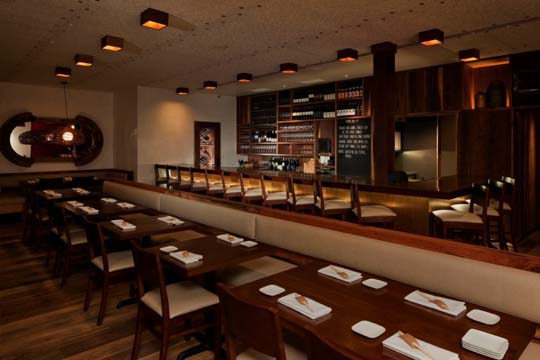 , New York, and Austin, where he had
risen up the brigade at restaurant Musashino. "
, New York, and Austin, where he had
risen up the brigade at restaurant Musashino. "
The food at Uchiko is,
apparently, very close to but somewhat more
extensive than the menu at Uchi, and there are
always daily specials. Our group cast our
nets widely, from "Cool Tastings" of sushi and
sashimi--the yellowtail sashimi with Thai chili
and orange was superb--to agemono
fried dishes like tempura onion rings with togarashi
pepper and white soy. The "Hot Tastings'
included chicken with sweet rice, banana leaf,
and Thai chili vinaigrette,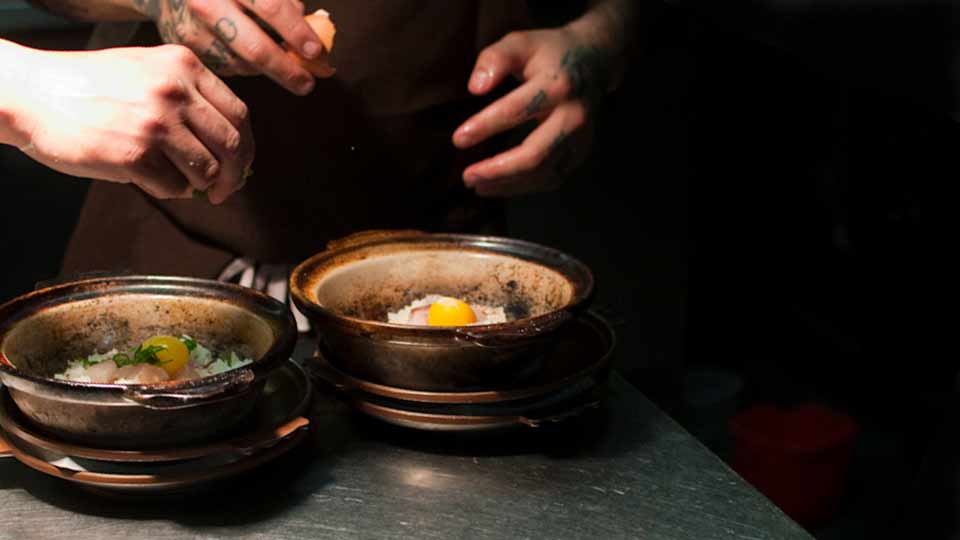 while the yakimono
items had an irresistible grilled Kurobuta pork
belly with pecan soi.
while the yakimono
items had an irresistible grilled Kurobuta pork
belly with pecan soi.
The many sushi and sashimi
offerings by the piece range in price from $2.50
to $18, and the makimono rolls $9-$14. I
was intrigued by and thoroughly enjoyed the
"P-38 Japanese yellowtail" with avocado,
spicy yuzu
kosho, grilled negi scallions,
and cilantro,
wondering as I ate it if the P-38 mentioned was
the World War II fighter plane that shot down
Admiral Yamamoto, the reluctant planner of the
attack on Pearl Harbor. Hard to imagine.
Cole's food shows the
influence of western ideas on Japanese cuisine,
with a bit of Peruvian influence from Nobu
Matsuhisa, but in its dash and its
expansiveness, Uchiko is blatantly, proudly a
Texas-style sushi bar, and the fact that it
turns out such exceptional quality for so many
people each night is testament not only to
Cole's professionalism but to an American belief
that if you want to do something badly enough
you can do it very well indeed.
❖❖❖
NEW YORK
CORNER
by
John Mariani
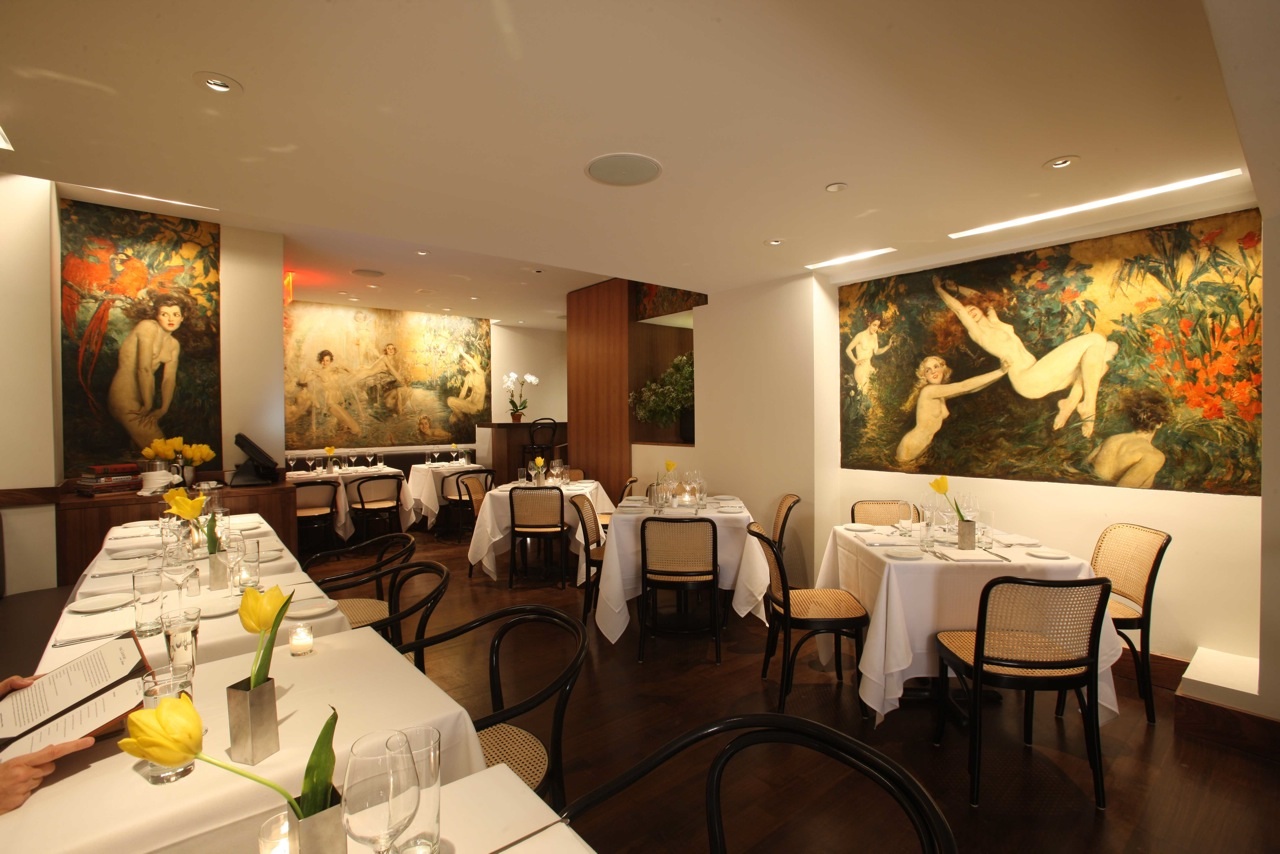 The
Leopard at des Artistes
The
Leopard at des Artistes
1
West 67th Street (near
Central Park West)
212-787-8767
www.theleopardnyc.com
Only one thing could have made me happier than the re-opening of the space known, for nearly a century, as the Café des Artistes, and that was the news that Gianfranco and Paula Sorrentino, who also own Il Gattopardo across from the MOMA, have taken the space and made it into The Leopard at Des Artistes. Long owned by George and Jenifer Harvey Lang, the venerable spot with its incomparable Howard Chandler Christy murals of 36 nude nymphs who look very much like 1930s chorus girls romping in Central Park, had union problems that drove it out of business two years ago, and there was a good deal of worry that, like Tavern on the Green, it would never re-open.
I do not know what the Sorrentinos, being consummate professional restaurateurs, were able to arrange with the unions, but their reclaiming this glorious space, now with its murals refreshed and softly lighted, makes this one of the most stunningly beautiful dining venues in the only city where it makes total sense. The Hôtel des Artistes, actually a residence, in which the restaurant is located is itself a fine work of NYC Gothic-Tudor architecture, originally opened as an artists' studio. Christy, known for his far more demure "Christy girls" graphic art, showed a very different side of his talent in the naughty murals that have been a fixture here since the '30s, as inseparable from the city's popular culture as the NYC Public Library lions or Maxfield Parrish's "Old King Cole" mural at the King Cole Bar in the St. Régis Hotel.
At the time of the Café's closing, the NY Times wrote that its had "stayed frozen in time, like an Upper West Side Miss Havisham," which is a complete misreading of the mad dowager in Dickens's Great Expectations who lived in a hoary darkened mansion amidst decades of rat-infested decay. Indeed, till the day the Café closed it was vibrant and gay, despite a few tatters here and there.
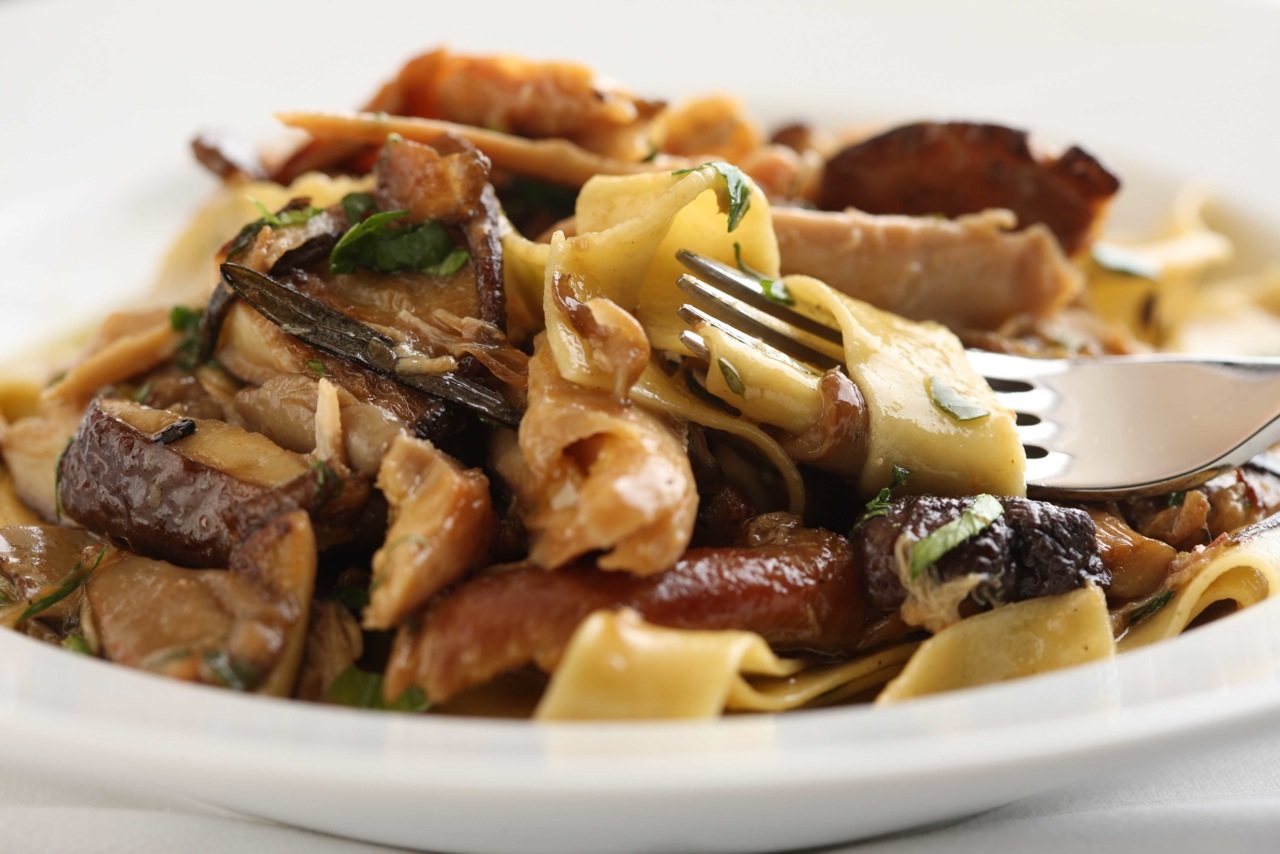
Now, with a thorough sprucing up with dark woods and tile floors, the Leopard is enchanting, and from the day it opened last year, it's been flocked with old regulars of the Café, theater- and opera-goers, and out-of-town visitors who either remember the old days fondly or always wanted to go here.
When this was the Café, the menu was of a continental mode, with some Hungarian touches that evoked the late George Lang's heritage. Now, under Chef Vito Gnazzo, those evocations are Southern Italian, and the whole menu is a careful balance of classic New York Italian dishes and new ones not readily found anywhere else--except at the Sorrentinos' sister restaurant Il Gattopardo, where Gnazzo offers a menu very close to The Leopard's. The wine list has plenty of bottles under $50, too.
You will sit down to good bread and grissini and a gift of crisp fried rice balls while you decide if you want to order antipasti, pasta, and main courses. Whatever you choose, the eggplant and smoked mozzarella timballo with spicy tomato sauce is very good, as are the veal meatballs in a similar sauce. One of the best examples this side of the Mediterranean of puntarelle-- wild chicory spears, dressed with olive oil, lemon, and anchovies--was a special one night and I hope they manage to serve it often, when the greens are at their peak.
With names like Sorrentino and Gnazzo, the owners and chef are going to give their all to lusty pastas like the bucatini with sardines, onions, wild fennel, pine nuts and raisins, and I thoroughly enjoyed the housemade Abruzzese spaghetti alla chitarra with a simple sherry tomato and basil sauce. Flat, hollow macaroni called paccheri are graced with a cod and cauliflower ragù, while pappardelle are treated to an abundance of roasted rabbit meal and wild mushrooms. Rigatoni alla Norma, a Sicilian dish named after Bellini's 1821 opera "Norma," is delicious with sautéed eggplant and aged ricotta cheese.
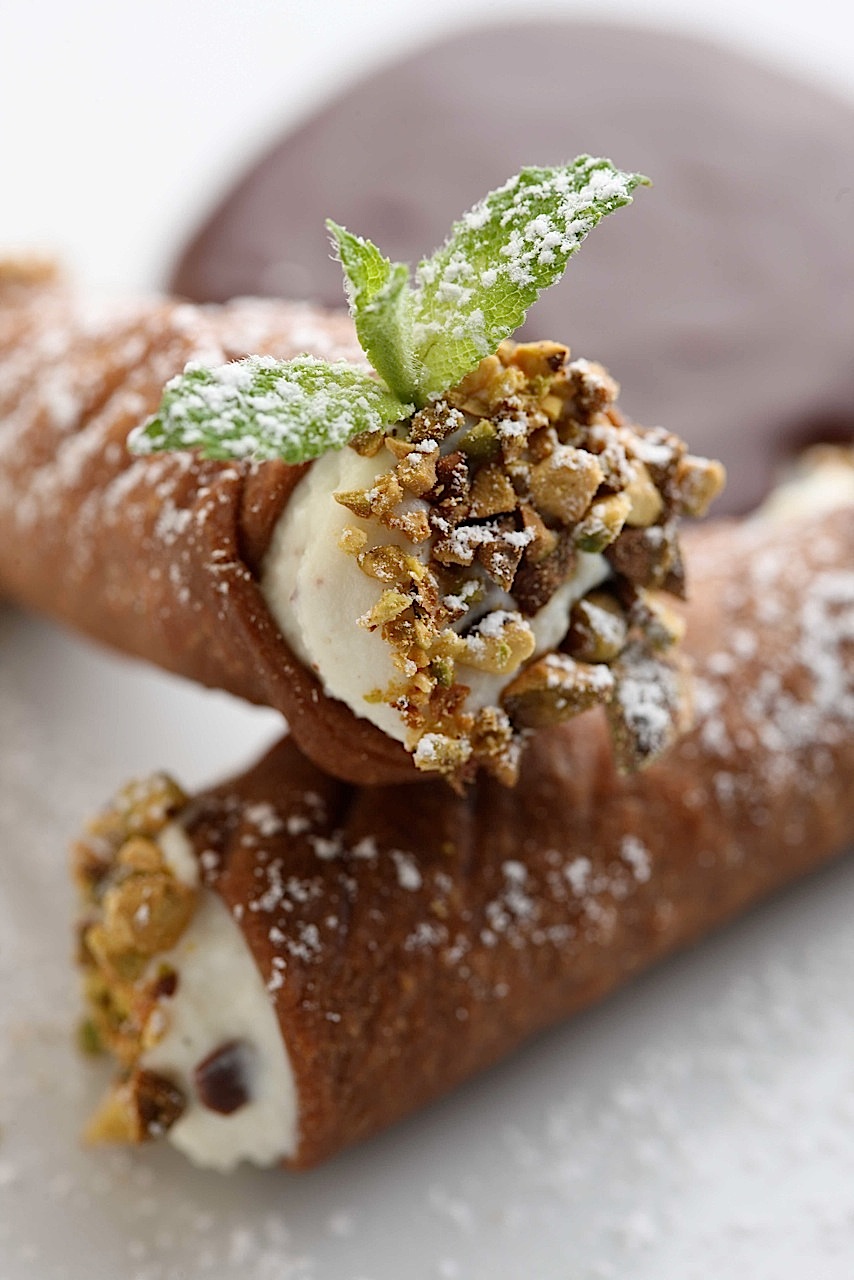 The stand-out entree at The
Leopard, also available at Il Gattopardo (which means
"leopard" in Italian), is the meatloaf, one of those
dishes foodies have claimed as the new prole food,
although it's been a part of the Gnazzo repertoire for
years, a very juicy and tasty meatloaf with mashed
potatoes and sautéed garlic-riddled
spinach. Veal is sliced thin and served with a
veal sauce and asparagus, a safe choice, and while I
enjoyed the porchetta
of roast pig, one night the skin was not particularly
crisp. Fish is done nicely here, especially the
de-boned Dover sole, the most expensive thing on the
menu at $40.
The stand-out entree at The
Leopard, also available at Il Gattopardo (which means
"leopard" in Italian), is the meatloaf, one of those
dishes foodies have claimed as the new prole food,
although it's been a part of the Gnazzo repertoire for
years, a very juicy and tasty meatloaf with mashed
potatoes and sautéed garlic-riddled
spinach. Veal is sliced thin and served with a
veal sauce and asparagus, a safe choice, and while I
enjoyed the porchetta
of roast pig, one night the skin was not particularly
crisp. Fish is done nicely here, especially the
de-boned Dover sole, the most expensive thing on the
menu at $40.Share a dessert, or two, or three, and you'll be rewarded with some terrific traditional sweets, including a marvelous pannacotta made with mascarpone and a luscious caramel semifreddo with an unexpected and very good bitter orange sauce. There's even a good cannolo made with sheep's milk ricotta and chocolate chips.
The Leopard is a happy place, and people are very happy that it is thriving. It's good to be back within that quintessential NYC atmosphere, and the Sorrentinos are making sure that you will be coming back again and again.
Lunch
Mon.-Fri., dinner nightly, brunch Sat. & Sun.
Appetizers, $9 to $15; pastas, $18 to $22; entrees,
$24 to $46.
❖❖❖
A RAPID RISE IN
CROATIAN WINE QUALITY,
BUT NOW HOW AND WHERE TO SELL IT?
 Back when Croatia was
part of Yugoslavia, government farm policies ripped
out more than 160,000 hectares of vineyards; the
ethnic wars of the 1990s destroyed thousands more.
Now, built up to 33,000 hectares under cultivation,
Croatian winemakers have to fight their way into a
global market saturated with wine when they enter the
EU in 2013. Currently
Croatia exports only five percent of its annual
production of 60 million liters, which helps explain
why Croatians are third overall in wine consumption.
Back when Croatia was
part of Yugoslavia, government farm policies ripped
out more than 160,000 hectares of vineyards; the
ethnic wars of the 1990s destroyed thousands more.
Now, built up to 33,000 hectares under cultivation,
Croatian winemakers have to fight their way into a
global market saturated with wine when they enter the
EU in 2013. Currently
Croatia exports only five percent of its annual
production of 60 million liters, which helps explain
why Croatians are third overall in wine consumption.
The industry got a boost when the popular
California varietal zinfandel was traced back to
Croatia, as a parent to the clone called plavac mali
(“little blue”), a discovery that helped focus an
industry that once made 650 different wines from 130
varietals.
Another catalyst was native son Miljenko Grgic,
who left Yugoslavia in 1958, eventually to make his
fortune as one of California’s premier winemakers
named Mike Grgich, and later returned to help
modernize Croatian wineries, not least by opening his
own, Grgic Vina, in 1996. The change from producing
cheap bulk wine to modern viticulture has been rapid,
with stainless steel tanks introduced only in the
1990s, and the burgeoning industry is full of youthful
enthusiasm.
“I had no wine knowledge before getting
into making it,” said Bruno Trapan, 32, an Istrian who
invested in the business in 2004 after taking a
college winemaking course two years earlier. “My
grandfather planted grapes in a tiny vineyard as a
hobby and I was interested. After two vintages making
my own wine, I was hooked.” By 2005 he had purchased
five hectares and did plantings a year later,
experimenting with international varietals like syrah,
never before grown in Croatia. By 2009 Trapan’s was
the country’s first organic winery, now with 12
hectares producing everything from traditional
malvasia to new entries like chardonnay and cabernet
sauvignon.
I interviewed Trapan and two other
contemporary Croatian vintners over a dinner of
lobster, crab cakes, steaks, and onion rings at New
York’s Porter
House. Trapan’s white Ponente Malvasia Istriana 2010 (US
price n/a), never aged in oak, had a lovely, bold
aromatic nose, which came from seven hours of skin
contact, and an ample 13.5 percent alcohol. The 2009
syrah (price n/a) had an odd smell at first, but it
evaporated to reveal a Rhone-like varietal character
rather than the Australian shiraz style.
Porter House’s wine director Roger
Dagorn carries a 2008 Dingač plavic mail ($65 retail)
from Croatia’s southern coast. “The few Croatian wines I’ve
tasted are not all great,” he told me, “but I’m fond
of the plavac mali for its unique, Old World earthy
character, which is very pleasurable to the American
palate. It has good structure, body and fruit, and
enough acidity to give it balance.”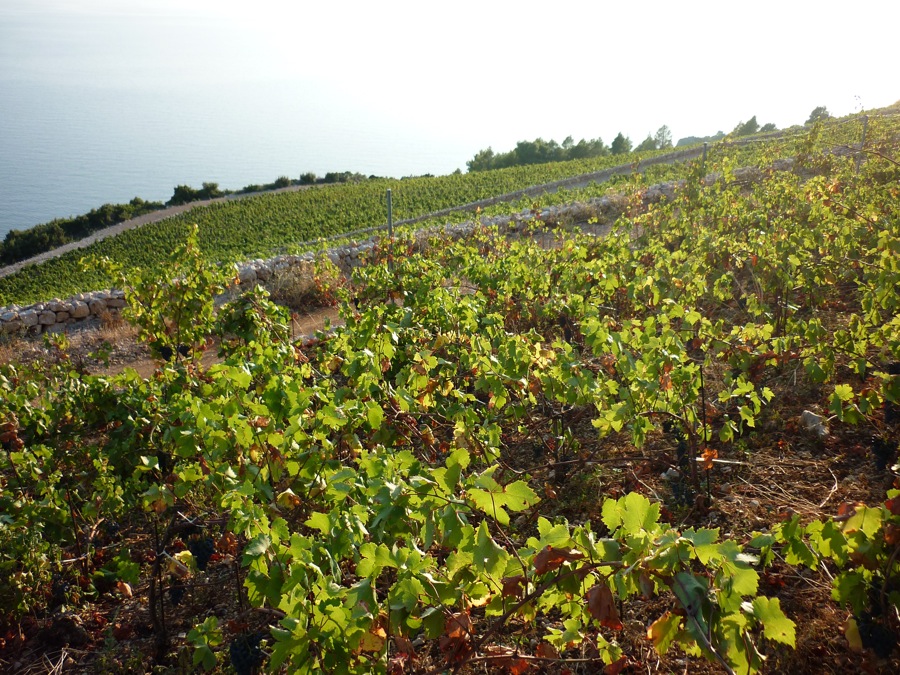
I
felt quite the same way about this big-bodied wine
with 15 percent alcohol, from the Saints Hills Winery,
founded 2006. Made in low yields, the steep terraced
vineyards in Dalmatia give the wine plenty of
minerality. Dingač is one of the rare, cherished
appellations, dating back to 1961, when Croatia was
part of Yugoslavia. Saints Hills is owned by Ernest
Tolj, 40, a wealthy entrepreneur and Chairman of the
Board of Eurocable Group, who named his vineyards
after his children, Lucia, Roko, and Ante, and who
hired controversial Bordeaux enologist Michel Rolland
onboard as a consultant.
Of
all the wines I tasted that evening, the Matosevic Winery Alba
Antiqua 2008 had the most viticultural
history behind it. Owner Ivica Matošević, 47, now
considered a visionary in the wine industry, took a
degree in landscaping and horticulture at the
University of Zagreb, followed by a PhD in
Biotechonology in Italy, focusing on the potential of
terroir. Matošević
returned to Croatia in 1996 at a crucial point in
the industry’s redevelopment, as director for the
Istrian Regional Institute for Managing Natural
Protected Areas. He also bottled his own first vintage
that year. In 2011 he established the association of
Croatian Wine Producers to represent family estates
and small producers.
His Alba Antiqua is 100 percent
Malvasia Istriana, with 12.7 percent alcohol, and was
very unusual in aroma, highly floral, which I learned
comes from aging it in acacia barrels.
Matošević’s
Grimalda White
2009 was a blend of 50 percent
chardonnay, 25 percent Malvasia Istriana, and 25
percent sauvignon blanc, a very low-yield wine that
showed the triple punch of those grapes, with the rich
buttery taste of the chardonnay, the floral notes of
the malvasia, and the vegetal flavors of the sauvignon
blanc.
The
Grimalda Red 2009,
at a robust 15 percent alcohol, was a blend of 85
percent merlot and 15 percent teran, this last an
acidic varietal that gives a coppery edge to the soft
merlot.
While
Porter
House was filled that night with people drinking
Bordeaux and California cabs, I was happy to sip
malvasia Istriana with my lobster salad and the Dingač
with the sliced steak. And with onion rings, that
Croatian syrah really hit the spot.
Photos:
Cliff Rames
John Mariani's wine column appears in Bloomberg Muse News, from which this story was adapted. Bloomberg News covers Culture from art, books, and theater to wine, travel, and food on a daily basis.
❖❖❖

Parents afraid of vaccinations are contacting other parents who, according to the NY Daily News, "mail them lollipops licked by children with chickenpox," so that their uninfected child may become immune. The newspaper notes that, "Aside from the fact that this is idiotic (not to mention a waste of perfectly good lollipops), it's also illegal. "
 LA DEE DAH,
LAH DEE DAH. . .DAH.
LA DEE DAH,
LAH DEE DAH. . .DAH."It rolls in slow motion, edges vignetted,
focus softened. And yet, the memory of my meal at
Louis XV is as crisp and clean as those linens that
hugged my table, as rich as the sauces and gold that gilt each
plate. What can you say to pampering and
perfection? Yes, please! Louis XV is one of the
only restaurants left that argues for grandeur beyond
hope and spoils with excess beyond reason. And yet it
is not a relic. It is very relevant. It is a
masterpiece. As I wrote earlier this year:
behold, proud, prodigal, peerless."— Ulterior Epicure.
❖❖❖
Any of John Mariani's
books below may be ordered from amazon.com.
 |
My latest book, which just won the prize for best book from International Gourmand, written with Jim Heimann and Steven Heller, Menu Design in America, 1850-1985 (Taschen Books), has just appeared, with nearly 1,000 beautiful, historic, hilarious, sometimes shocking menus dating back to before the Civil War and going through the Gilded Age, the Jazz Age, the Depression, the nightclub era of the 1930s and 1940s, the Space Age era, and the age when menus were a form of advertising in innovative explosions of color and modern design. The book is a chronicle of changing tastes and mores and says as much about America as about its food and drink.
“Luxuriating vicariously in the pleasures of this book. . . you can’t help but become hungry. . .for the food of course, but also for something more: the bygone days of our country’s splendidly rich and complex past. Epicureans of both good food and artful design will do well to make it their cofee table’s main course.”—Chip Kidd, Wall Street Journal.
“[The menus] reflect the amazing craftsmanship that many restaurants applied to their bills of fare, and suggest that today’s restaurateurs could learn a lot from their predecessors.”—Rebecca Marx, The Village Voice. |
"Eating Italian will never be the same after reading John Mariani's entertaining and savory gastronomical history of the cuisine of Italy and how it won over appetites worldwide. . . . This book is such a tasteful narrative that it will literally make you hungry for Italian food and arouse your appetite for gastronomical history."--Don Oldenburg, USA Today. "Italian
restaurants--some good, some glitzy--far
outnumber their French rivals. Many of
these establishments are zestfully described
in How Italian Food Conquered the World, an
entertaining and fact-filled chronicle by
food-and-wine correspondent John F.
Mariani."--Aram Bakshian Jr., Wall Street
Journal.
"Equal parts
history, sociology, gastronomy, and just
plain fun, How Italian Food Conquered the
World tells the captivating and delicious
story of the (let's face it) everybody's
favorite cuisine with clarity, verve and
more than one surprise."--Colman Andrews,
editorial director of The Daily
Meal.com. "A fantastic and fascinating
read, covering everything from the influence
of Venice's spice trade to the impact of
Italian immigrants in America and the
evolution of alta cucina. This book will
serve as a terrific resource to anyone
interested in the real story of Italian
food."--Mary Ann Esposito, host of PBS-TV's
Ciao
Italia. "John Mariani has written the
definitive history of how Italians won their
way into our hearts, minds, and
stomachs. It's a story of pleasure over
pomp and taste over technique."--Danny Meyer,
owner of NYC restaurants Union Square Cafe,
Gotham Bar & Grill, The Modern, and
Maialino.
|
 |
 |
 |
 |
 |
 |
 |
 |
 Everett Potter's Travel Report:
Everett Potter's Travel Report: 
 Eating Las Vegas
is the new on-line site for Virtual Gourmet
contributor John A. Curtas., who since 1995
has been commenting on the Las Vegas food
scene and reviewing restaurants for Nevada
Public Radio. He is also the
restaurant critic for KLAS TV, Channel 8 in
Las Vegas, and his past reviews can be
accessed at KNPR.org.
Click on the logo below to go directly to
his site.
Eating Las Vegas
is the new on-line site for Virtual Gourmet
contributor John A. Curtas., who since 1995
has been commenting on the Las Vegas food
scene and reviewing restaurants for Nevada
Public Radio. He is also the
restaurant critic for KLAS TV, Channel 8 in
Las Vegas, and his past reviews can be
accessed at KNPR.org.
Click on the logo below to go directly to
his site.

Tennis Resorts Online: A Critical Guide to the World's Best Tennis Resorts and Tennis Camps, published by ROGER COX, who has spent more than two decades writing about tennis travel, including a 17-year stretch for Tennis magazine. He has also written for Arthur Frommer's Budget Travel, New York Magazine, Travel & Leisure, Esquire, Money, USTA Magazine, Men's Journal, and The Robb Report. He has authored two books-The World's Best Tennis Vacations (Stephen Greene Press/Viking Penguin, 1990) and The Best Places to Stay in the Rockies (Houghton Mifflin, 1992 & 1994), and the Melbourne (Australia) chapter to the Wall Street Journal Business Guide to Cities of the Pacific Rim (Fodor's Travel Guides, 1991).


The Family Travel Forum - A
community for those who "Have Kids, Still Travel" and
want to make family vacations more fun, less work and
better value. FTF's travel and parenting features,
including reviews of tropical and ski resorts, reunion
destinations, attractions, holiday weekends, family
festivals, cruises, and all kinds of vacation ideas
should be the first port of call for family vacation
planners. http://www.familytravelforum.com/index.html
ALL YOU NEED BEFORE YOU GO


MARIANI'S VIRTUAL GOURMET
NEWSLETTER is published weekly. Editor/Publisher: John
Mariani.
Contributing Writers: Christopher Mariani, Robert Mariani,
John A. Curtas, Edward Brivio, Mort Hochstein,
Suzanne Wright, and Brian Freedman. Contributing
Photographers: Galina Stepanoff-Dargery,
Bobby Pirillo. Technical Advisor: Gerry McLoughlin.
© copyright John Mariani 2012
